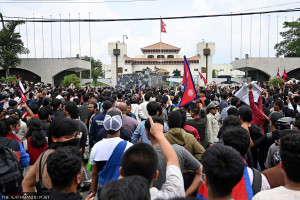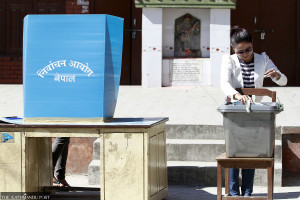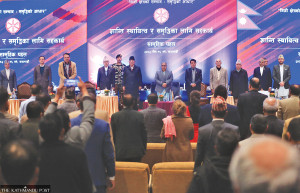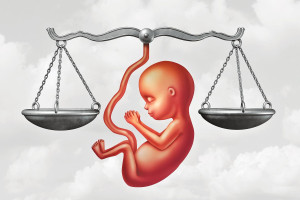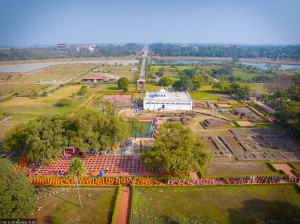Opinion
The struggle within
Indigenous movements must acknowledge women’s issues, not just limited to reproduction and sexuality
Tashi Tewa Dolpo
M. Bahati Kuumba, in her work Gender and Social Movements, emphasises the distinct experiences of men and women in starting and participating in movements. Kuumba compels us to look beyond social realities and rethink basic assumptions by identifying and confronting inherent gender biases implicit in movements for social change.
Every state generally has raised issues of nationality and identity. Subsequently, indigenous movements for political identity have emerged in Mexico, Latin America and South Asia. These movements spread dialogue and ideas between local and international activists and organisations, and women constituted a significant part of these movements. Nonetheless, their contributions were seemingly neither promoted nor considered in the grand narratives of these movements, as they continued to be andocentric and dominated by male biases. This article, therefore, will discuss the linkages between gender and indigenous movements in reference to the recent Dolpo protests and the consequent candle-light peace march. I will also consider the organisational aspects that have remained influential in these movements.
The Dolpo protests
The reasons behind the Dolpo protests have already been examined in my previous articles (‘An alternative to violence,’ June 14, Page 6). However, when a protest was organised near Bhadrakali, most women either did not participate or were not asked to participate. When a meeting was held to organise the protest, only chairpersons and secretaries of organisations working in the Upper Dolpa region were invited, and most of these posts were held by men. This too prevented women from participating meaningfully in the protests.
Likewise, Kailash Rai has argued that the National Indigenous Women Federation (NIWF) was established from a coalition of previous indigenous women’s organisations affiliated with the Nepal Federation of Indigenous Nationalities (Nefin), when the latter failed to be more sensitive towards the rights of indigenous women. Besides, Tapiya Darai, Roshani Meche, Chiniyamaya Majhi and Yasodha Choudhari as vice-chairpersons and secretaries in the Nefin secretariat federal council, there are few other indigenous women representatives. Indigenous women are still not motivated to contest top posts and are restricted to minor roles. This has remained the case ever since Nefin was established. The maneuvering and mobilisation of respected elder leaders including, general secretaries and chairpersons, primarily men, behind the curtains for consensus on electing men at the next general convention need to be examined properly by NIWF. How these practices reflect social attitudes, behaviours and cultures of indigenous peoples also need reflection.
Contrary to the Dolpo protests, the Dolpo peace march might have upset certain Dolpo men. During the march from Boudha to Chuchhepati, most men were at the front with banners but there were also many women raising their voices for justice for the dead and victims of Do-Tarap. While raising slogans like ‘We are Nepali’ and ‘We Want Justice,’ these women continued to raise their voices. Some women even asked the men to raise their voices when the men were silent as the march reached Chuchhepati. Unquestionably, women were more active in the march and also reconfirmed their ability to overcome social and structural challenges.
‘Larger issues’
In the master narrative of these movements, protests and marches, women and their contribution are not promoted. In the general discourse of the indigenous movement, Yalambar and Lakhan Thapa continue to outshine their partners’ assistance. In a recent joint struggle committee meeting conducted by Nefin, compared to more than 20 indigenous men, only seven to eight indigenous women participated. There is an increase in the participation of women, but still comparatively less in the decision-making processes of protest management.
Social scientist Pratyoush Onta has shared how certain indigenous activists reacted to a programme more than a decade ago when a participant asked them about gender equality among indigenous people. According to Onta, some ethnic activists, mainly men, simply diverted the question towards broader structural challenges for indigenous people while neglecting the nuances of gender equality. From this, one can argue that indigenous women’s issues are often sacrificed for on the altar of ‘larger issues’ by indigenous leaders and activists.
Triply subjugated
Courtney Jung, in her work The Moral Force of Indigenous Politics, argues that indigenous politics, including an indigenous identity, arose to give voice to the excluded and dispossessed while acknowledging historical exclusion and marginalisation. The time has also come to look at exclusionary tendencies even within this discourse and practices of indigenous politics of identity. Jung emphasises that “the indigenous woman, stands as a reproach to the ambition of neo-liberal globalisation; she is the emancipatory subject of our time”. Indigenous cultures should be transformed to respect the rights of women within indigenous groups. Women are important in the defence of indigenous cultures against liberal critics while becoming democratic, supportive and non-secessionist. Women’s participation might also contribute to the reversal of democratic recession.
Therefore, when Sierra Tamang writes for indigenous women; Yasso Kanti Bhattachan writes about the significance of the indigenous women’s movement; Shanti Jirel leads the indigenous women’s organisation at the national level; and when Rajendra Pradhan reveals both the coexistence of gender egalitarianism and ‘inegalitarianism’ within indigenous communities, most Adivasi/Janajati activists and intellectuals also need to reflect on their own ‘masculine political culture’ while critiquing the nationalist and homogenising culture of the state. Indigenous movements and leaders, therefore, should accommodate and acknowledge distinct indigenous women’s issues, which is not only restricted to health, reproduction and sexuality. Women are dealing with triple subjugation: as women, being indigenous and as indigenous women; we should not forget the diversity within these groups.
Tewa Dolpo is currently working as a Research Assistant at the Nepa School of Social Sciences




 16.57°C Kathmandu
16.57°C Kathmandu







